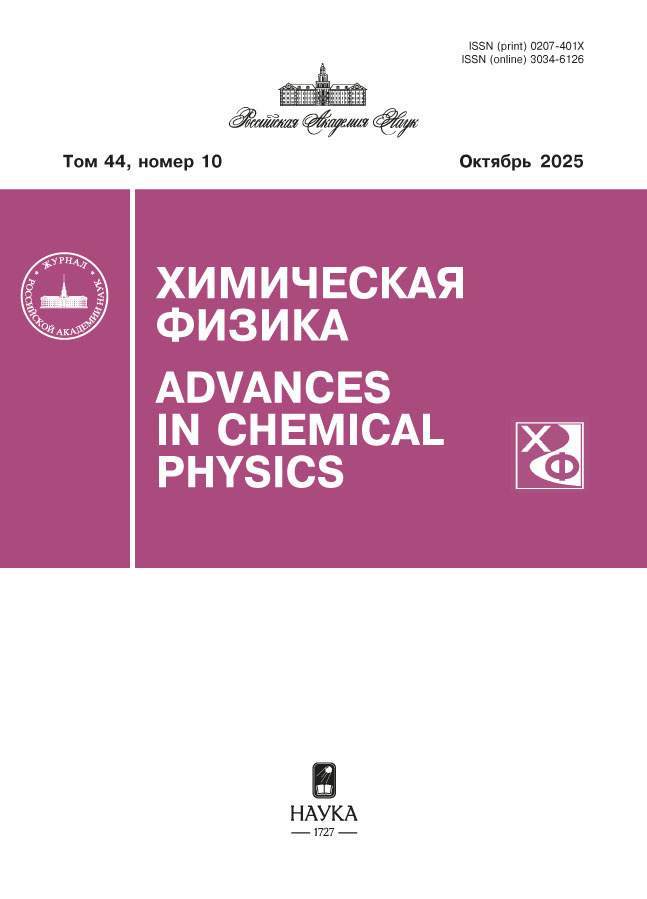Spectral model for calculation of radiation characteristics of shock heated gas
- Authors: Bykova N.G.1, Kusov A.L.1, Kozlov P.V.1, Gerasimov G.Y.1, Levashov V.Y.1, Zabelinsky I.E.1
-
Affiliations:
- Institute of Mechanics, Lomonosov Moscow State University
- Issue: Vol 43, No 6 (2024)
- Pages: 33-40
- Section: Combustion, explosion and shock waves
- URL: https://cardiosomatics.orscience.ru/0207-401X/article/view/674934
- DOI: https://doi.org/10.31857/S0207401X24060042
- ID: 674934
Cite item
Abstract
The extended version of the previously developed computational procedure SPECTRUM is presented, which allows to calculate the radiation characteristics of a shock-heated gas, taking into account the decrease in the radiation intensity in an absorbing medium. The procedure is based on line-by-line calculation of the emission and absorption spectra of atoms and molecules that make up the gas mixture under study. When calculating the emission spectra of atoms and molecules, the values of spectroscopic constants were taken from known databases. The results of calculating the time-integrated spectral characteristics of shock-heated air are compared with the available experimental data obtained in the ultraviolet, visible, and infrared regions of the spectrum.
Full Text
About the authors
N. G. Bykova
Institute of Mechanics, Lomonosov Moscow State University
Email: levashovvy@imec.msu.ru
Russian Federation, Moscow
A. L. Kusov
Institute of Mechanics, Lomonosov Moscow State University
Email: levashovvy@imec.msu.ru
Russian Federation, Moscow
P. V. Kozlov
Institute of Mechanics, Lomonosov Moscow State University
Email: levashovvy@imec.msu.ru
Russian Federation, Moscow
G. Ya. Gerasimov
Institute of Mechanics, Lomonosov Moscow State University
Email: levashovvy@imec.msu.ru
Russian Federation, Moscow
V. Yu. Levashov
Institute of Mechanics, Lomonosov Moscow State University
Author for correspondence.
Email: vyl69@mail.ru
Russian Federation, Moscow
I. E. Zabelinsky
Institute of Mechanics, Lomonosov Moscow State University
Email: levashovvy@imec.msu.ru
Russian Federation, Moscow
References
- Uyanna O., Najafi H. // Acta Astronaut. 2020. V. 176. P. 341.
- Zhao Y., Huang H. // Ibid. 2020. V. 169. P. 84.
- Surzhikov S.T. // Rus. J. Phys. Chem. B 2010. V. 4. P. 613.
- Reyner P. // Prog. Aerospace Sci. 2016. V. 85. P. 1.
- Gu S., Olivier H. // Prog. Aerospace Sci. 2020. V. 113. No. 100607.
- Zabelinskii I.E., Kozlov P.V., Akimov Yu.V., Bykoba N.G., Gerasimov G.Ya., Tunik Yu.V., Levashov V.Yu. // Rus. J. Phys. Chem. B 2021. V. 15. P. 963.
- Gerasimov G.Ya., Kozlov P.V., Zabelinsky I.E., Bykova N.G., Levashov V.Yu. // Rus. J. Phys. Chem. B 2022. V. 16. P. 642.
- Whiting E., Park C., Liu Y., Arnold J., Paterson J. // NASA Ref. Publ. 1996. № 1389.
- Johnston C.O., Hollis B.R., Sutton K. // J. Spacecraft Rockets. 2008. V. 45. № 5. P. 865.
- Kumar N., Bansal A. // Acta Astronaut. 2023. V. 205. P. 172.
- Johnston C.O., Hollis B.R., Sutton K. // J. Spacecr. Rockets. 2008. V. 45. P. 879.
- Lemal A., Jacobs C.M., Perrin M.-Y. et al. // J. Thermophys. Heat Transf. 2016. V. 30. P. 197.
- Karpuzcu I.T., Jouffray M.P., Levin D.A. // J. Thermophys. Heat Transf. 2022. V. 36. P. 982.
- Du Y.W., Sun S.R., Tan M.J et al. // Acta Astronaut. 2022. V. 193. P. 521.
- Dikalyuk A.S., Surzhikov S.T., Kozlov P.V., Shatalov O.P., Romanenko Y.V. AIAA Paper. 2013. № 2013–2505.
- Umanskii S.Y., Adamson S.O., Vetchinkin A.S., Deminskii M.A., Olkhov O.A., Chaikina Y.A., Shushin A.I., Golubkov M.G. // Rus. J. Phys. Chem. B 2023. V. 7. P. 346.
- Zhu T., Li Z., Levin D.A. // J. Thermophys. Heat Transfer. 2014. V. 28. P. 623.
- Gimelshein S.F., Wysong I.J., Fangman A.J. et al. // Ibid. 2022. V. 36. P. 870.
- Kozlov P.V., Kusov A.L., Bykova N.G., Zabelinskii I.E., Levashov V.Yu., Gerasimov G.Ya. // Rus. J. Phys. Chem. 2023. V. 17. P. 456.
- Bykova N.G., Kuznetsova L.A. // Opt. Spectrosc. 2008. V. 105. P. 668.
- Wayne R.P. Principles and Applications of Photochemistry. Oxford University Press, Oxford, 1088.
- Nordebo S. // J. Quant. Spectrosc. Radiat. Transf. 2021. V. 270. № 107715.
- Surzhikov S.T. AIAA Paper. 2002. № 2002–2898.
- NIST Atomic Spectra Database, Ver. 5.10. Gaithersburg: NIST, 2021.
- https://doi.org/10.18434/T4W30F
- Arnold J.O., Whiting E.E., Lyle G.C. // J. Quant. Spectrosc. Radiat. Transf. 1969. V. 9. P. 775.
- Kuznetsova L.A., Kuzmenko N.E., Kuzyakov Yu.Ya., Plastinin Yu.A. Probabilities of optical transitions of diatomic molecules. Nauka, Moscow, 1980.
- Kuznetsova L.A., Surzhikov S.T. // Math. Model. 1998. V. 36. № 5. P. 15.
- Glushko V.P. (Ed.). Thermodynamic Properties of Individual Substances, V. II. Nauka, Moscow, 1979.
- Kozlov P.V., Zabelinsky I.E., Bykova N.G., Gerasimov G.Ya., Levashov V.Yu. // Fluid Dynamics. 2022. V. 57. P. 780.
- Kozlov P.V., Zabelinsky I.E., Bykova N.G., Gerasimov G.Ya., Levashov V.Yu. // Fluid Dynamics. 2022. V. 58. P. 573.
- Surzhikov S.T. // Phys.-Chem. Kinet. Gaz. Dynam. 2022. V. 23. № 4. P. 1.
- Johnston C.O. AIAA Paper. 2008. № 2008–1245.
Supplementary files

















